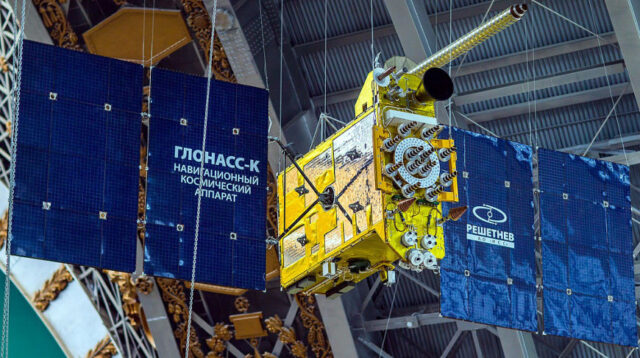
Russia’s Satellite Constellation Deteriorates, Increasing Dependency on China
Publication: Eurasia Daily Monitor Volume: 21 Issue: 69
By:

Executive Summary:
- Russia’s dual-use Global Navigation Satellite System (GLONASS) is running into roadblocks due to technological deterioration, freeing Moscow to become more aggressive in space affairs.
- The Russian space industry had relied on stores of imported components to weather the first rounds of Western sanctions, but now it is increasingly reliant on Chinese-made electronics.
- The use of Chinese parts in Russian navigation satellites hurts prospects for GLONASS to be fully modernized by 2030.
The Russian dual-use Global Navigation Satellite System (GLONASS; Globalnaya Navigatsionnaya Sputnikovaya Sistema) currently faces several crucial challenges and delays. Moscow’s ability to transition from its outdated satellites to a relatively more advanced generation or to develop Tundra-orbit navigation satellites has severely weakened. The technological deterioration has become a significant issue and may be irreversible, leading to Russia’s satellite constellations to become even more outdated than they already are. As a result, the Kremlin has become bolder and more aggressive in space affairs, including the jamming of global positioning system (GPS) signals over the Baltic Sea region. These developments look to make Russia ever-more dependent on China (Financial Times, April 28; Novaya Gazeta, April 29).
Since 2020, the Russian GLOSNASS constellation has faced age-related challenges. Four years ago, 13 of the 24 GLONASS system satellites were GLONASS-M generation and has already exceeded their seven-year warranted lifetime. The replacement of these with GLONASS-K generation satellites was slower than expected, and the new satellites became even more dependent on Western electronics than the older generation (see EDM, April 27, 2020, January 22, 2021).
Over the past four years, Russia has put six navigation satellites into orbit—two GLONASS-M and four GLONASS-K satellites. Yet, at the time of writing, the number of satellites that have exceeded their warranted lifetime has increased to 15 of the 26 active satellites. Moreover, 22 navigation satellites, in theory, need to be replaced by 2030 before their lifetime expires (Glonass-iac.ru, accessed May 2).
Russia began the development of a new GLONASS architecture several years ago. This architecture is based on satellites deployed on high-elliptical Tundra orbits instead of medium orbits typical for GLONASS, GPS, and Galileo satellites. This approach resembles Japan’s Quasi-Zenith Satellite System (QZSS). Theoretically, such a development would allow Russia to produce sustainable and precise satellite navigation of its territory using six satellites instead of the current 18. The last information about the ongoing research and development program appeared in April 2022 when it was announced that the first satellite of this new type would appear no earlier than 2028, instead of the projected 2026–27 (Vestnik-glonass.ru, April 18, 2022).
Russia has not yet been able to solve the issue of aging constellations. As former Russian astronaut Fedor Yurchikhin recognized recently, there are growing troubles with manufacturing navigation satellites because of the lack of access to foreign electronic components and the absence of domestic production. According to him, the only way for Russia to build more navigation satellites is to use electronics made in China (Vestnik-glonass.ru, March 20).
The significant technical problems with the development of GLONASS-K satellites are becoming clearer. For example, satellites No. 7 and No. 703, put into orbit in October 2022 and August 2023, respectively, are still in the flight test phase and have not yet reached operational status. Satellite No. 703 is scheduled to replace GLONASS-M satellite No. 743, which has been in orbit almost five years longer than its warranted seven-year lifetime. (It was put into orbit in November 2011 and became operational in September 2012.) In addition, GLONASS-K satellite No. 702 was put into orbit in December 2014 and became operational in February 2016. The satellite, however, received technical service procedures 12 times from 2016 to 2023. For comparison, GLONASS-M satellite No. 751, which was put into orbit and integrated into the constellation in February 2016, has received technical service procedures only twice. Previously, Russia always had a reserve of orbited satellites and used them to replace decommissioned or broken satellites. These continuously renewed reserve satellites allowed Russia to replace 24 satellites in 16 orbital positions between 2014 and 2022, and three of those satellites changed their orbital positions from two to four times, replacing the older ones (Glonass-iac.ru, accessed May 2).
Russia had previously relied on storing imported components, allowing it to weather the first rounds of Western sanctions. At the time of writing, no orbited satellites are left in Moscow’s reserve, and the stores of imported components are also in question. In 2020–23, Russia orbited four of 11 GLONASS-K satellites that were contracted as early as 2016. This means imported electronic components for these satellites would have been purchased earlier. The actual technical state of these components in 2024 remains unclear. Simultaneously, the first GLONASS-K satellite manufactured using Russian-made electronic components is only expected in 2025, though that projection will likely need to be extended (RIA Novosti, March 1, 2016; VPK-news.ru, March 30, 2016; TASS, November 1, 2023).
The use of Chinese-made parts in Russian navigation satellites hurts prospects for GLONASS to be fully modernized by 2030. The further deterioration of the Russian system seems to be the most likely path. Unsurprisingly, Moscow is experimenting with interference and GPS signal jamming over the Baltic Sea region. Simultaneously, Russia is trying to extend the technical integration of the deteriorating GLONASS and developing China’s BeiDou navigation system as part of their expanded cooperation with China. (For more on BeiDou, see China Brief, March 1.) In Russia’s war against Ukraine, the Kremlin needs to maintain its armed forces and domestic transport infrastructure with satellite navigation signals in the case of a GLONASS failure or GPS signal cutoff (Government.ru, December 25, 2023).



